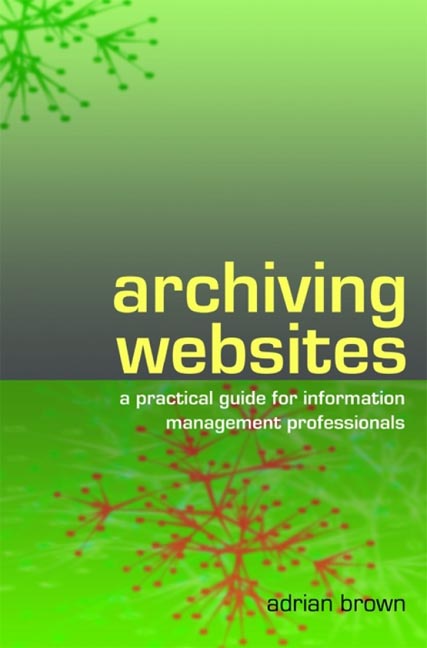Book contents
- Frontmatter
- Contents
- Acknowledgements
- Glossary
- 1 Introduction
- 2 The development of web archiving
- 3 Selection
- 4 Collection methods
- 5 Quality assurance and cataloguing
- 6 Preservation
- 7 Delivery to users
- 8 Legal issues
- 9 Managing a web archiving programme
- 10 Future trends
- Appendix 1 Web archiving and preservation tools
- Appendix 2 Model permissions form
- Appendix 3 Model test script
- Appendix 4 Model issues log
- Appendix 5 Model job description
- Bibliography
- Index
- Digital Preservation
- Frontmatter
- Contents
- Acknowledgements
- Glossary
- 1 Introduction
- 2 The development of web archiving
- 3 Selection
- 4 Collection methods
- 5 Quality assurance and cataloguing
- 6 Preservation
- 7 Delivery to users
- 8 Legal issues
- 9 Managing a web archiving programme
- 10 Future trends
- Appendix 1 Web archiving and preservation tools
- Appendix 2 Model permissions form
- Appendix 3 Model test script
- Appendix 4 Model issues log
- Appendix 5 Model job description
- Bibliography
- Index
- Digital Preservation
Summary
Introduction
This chapter provides an overview of the principles and practicalities of preserving archived web content over long periods of time. Digital preservation is a new and rapidly evolving discipline: the first comprehensive analysis of digital preservation as a global issue was only published in 1996 and, although significant advances have been made since then, mature solutions to the challenges are only now beginning to appear.
Preserving digital objects over long time periods presents a number of complex challenges, and a detailed discussion is beyond the scope of this book. This chapter discusses the major issues, and the key functions required to deliver a preservation service. These functions are common to the preservation of all types of digital content – the approach described can be applied equally to websites or anything else. Where web content does introduce particular issues, these are discussed at the end of the chapter.
The challenge of digital preservation
The purpose of preservation is to ensure the continued accessibility of an object over time, such that the inherent qualities of the object which merited its collection are maintained. In other words, successful preservation requires that the object be accessible to users, and that it retain its intrinsic value to those users. In the world of traditional collections, the principal obstacle to preservation is entropy. Physical materials suffer damage and decay: the acids present in paper damage its fibres, causing it to become brittle and discoloured over time; colour dyes in photographic films and prints continue to be chemically active, fading through exposure to light or high temperatures. Such concerns also apply to digital objects: the physical storage media will degrade over time, or may become corrupted. However, digital preservation must also overcome a unique and much more significant challenge – that of technological obsolescence.
Digital information is stored in the form of bits – ones and zeros which denote values in binary notation. These bits have no inherent meaning, but rather represent the encoding of information in accordance with some predefined scheme. Such information cannot be directly interpreted by a user, but rather requires the mediation of software capable of translating that information into human-readable form. To illustrate this, Figure 6.1 shows a small segment of a digital image encoded in the common TIFF file format, with the byte values expressed in hexadecimal notation.
- Type
- Chapter
- Information
- Archiving Websitesa practical guide for information management professionals, pp. 82 - 126Publisher: FacetPrint publication year: 2006



